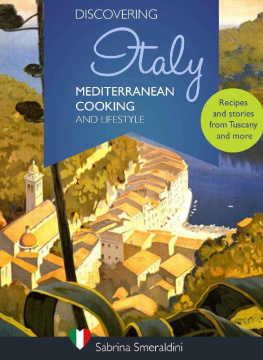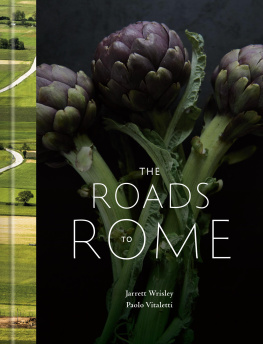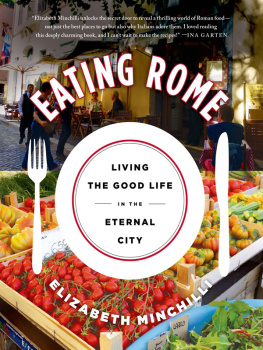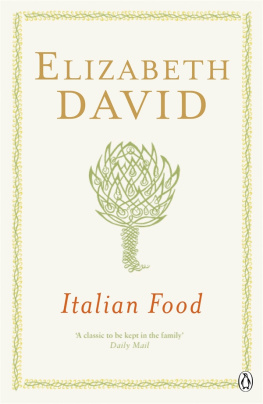C OOKING T HE R OMAN W AY
A UTHENTIC R ECIPES FROM THE
H OME C OOKS AND T RATTORIAS OF R OME
DAVID DOWNIE
Photographs by
ALISON HARRIS

For Romana Anzi-Downie and Charles E. Downie,
with boundless love and gratitude
CONTENTS

The Cooking of Rome
Close your eyes and imagine youre in Rome, seated al fresco in the sun on a rooftop terrace, smack in the center of town. Michelangelo did the decor on the Palazzo Farnese, framing the square below, and an ancient Roman sculptor, followed by several Renaissance architects, handled the mossy bathtub fountains poised like chess pieces in front of it. You hear the water splashing, accompanied by operatic voices and spluttering Vespas. Its early spring so theres still a bite in the air, but a thousand rooftop terraces and sidewalk tables already are filled with eager eaters. What, after all, can beat tucking into the pyramids of stuffed zucchini flowers fried golden in olive oil, the mounds of fresh fava beans and Pecorino Romano cheese, the braised artichokes alla romana and platters of rosemary-perfumed spring suckling lamb arranged before you? The answer is simple: Nothing.
Easy to make, good for you, gutsy, flavorful and fun to eatthats my one-line definition of Roman food. This cookbook brings you the luscious cuisine of the Eternal City, a rich culinary heritage built up over the last 2,800 years.
The enduring clich that all roads lead to Rome should have a corollary: Roman food has traveled down all roads. You might not realize it, but youve probably been enjoying Roman specialties foryears. Thats because some of the classics of Italian cooking come from Rome and the surrounding Latium region: bruschetta, spaghetti alla carbonara, bucatini allamatrkiana, fettuccine Alfredo, saltimbocca, buttery crostata (jam tart), tartufo (ice cream) and zabaglione. There are dozens more recipes of equal excellence in the Roman repertoire, and I hope you will be enticed to try them, too.
Its important to note that Roman food includes ingredients from many parts of Italy, notably Parmigiano-Reggiano and mascarpone cheeses from the north, balsamic vinegar from Modena, marsala from Sicily, pork products from Norcia to the northeast, fish from the Adriatic, San Marzano tomatoes from the Naples area and savoiardi (ladyfingers) from the Valle dAosta, bordering France. Romes cooking has been enriched by an overlay of influences, with several shared recipes from the adjoining regions of Campania, Abruzzi, Tuscany and Umbria. Above all, it encompasses specialties from throughout Latium (il Lazio in Italian), a pocket-size region wrapped around the city. Roman cooking is Lazio cooking adopted and adapted by the capitals cooks. The result: You neednt stray beyond the city walls to experience the regional foods of Viterbo, La Tuscia and Sabina north of Rome; Amatrice and Rieti to the east; the Alban Hills, Ciociaria, Latina, Gaeta and Frosinone to the south. Thousands of provincials from these districts have been pouring in and out of town for the last three millennia, bringing with them a bounty of produce and cooking styles. Consequently, the food of Rome includes anchovies, shark or dogfish, skate, scorpion fish, squid, octopus and mussels from the Mediterranean coast 10 miles from Rome at Ostia. Lamb and ewes milk cheeses, including Pecorino Romano, come from the rolling pasturelands that make much of Lazio look like a dreamy golf course. Cows or water buffalos milk mozzarella arrives daily from the hills of inland Frosinone or coastal Sperlonga, both south of Rome. The farmers of the rich fields of Fondi, a flat farm town on the way to Naples, and the volcanic Alban Hills overlooking Rome, flood the citys markets daily, year-round, with pale green, fluted Romanesco zucchini and their flowers, broccoli, broccoli rabe and peas. Olive groves spread from Lake Bolsena, bordering Tuscany, to Gaeta, edging Campania. Market gardens in the citys suburbs supply fresh herbsspearmint, basil, rosemary, sageplus several kinds of chicory and the numerous varieties of lettuces and field greens that go into misticanzasalad (see page 244). The towns of Ladispoli to the north and Sezze to the south vie for the title of Artichoke Capital of Lazio. Artichokes are a Roman specialty, not to say an obsession. There are dozens of recipes for them. Thanks to imports from other regions, plus hothouse production, theyre available year-round, and just in case the supply of fresh or pickled artichokes happens to run out, every Roman liqueur or medicine cabinet contains a bottle of the artichoke-based, dark, bitter and aromatic digestive liqueur called Cynar, or that other perennial favorite, Fernet-Branca, also made with artichoke essence.
Despite the inevitable social and economic upheavals Rome has undergone in its long history as a capital city, the cooking remains largely traditional. Historians point out that almost none of the dishes the ancient Romans ate are still prepared in the same way today, but many of the ancient cooking techniques, flavor combinations and favorite ingredients of centuries past are still popular. Take the celebrated ancient condiment garum, made from partly fermented anchovies or other fish mixed with sea salt. Romans today use salted anchovies (usually desalted and soaked in olive oil) to jazz up countless recipes. Country folk in the time of the emperors made dough, rolled it into various shapes, dried it, then tossed it into soups to thicken them. This proto-pasta was called tracta, and Romans today emulate their forebears by thickening their soups with pasta asciuttadry pasta. Eating habits are similar, too. The ancient Romans organized their menus much like contemporary Romans, calling the courses gustum (antipasti), mensa prima (primi), mensa secunda (secondi), with the dulcs in fundo (a surprise sweet or dolce at the end). Romans reach over the millennia to share a passion for pork fresh and cured, Pecorino Romano cheese, a wide range of herbs, grilled meats, bittersweet combinations, stuffing, eggs, frittatas, certain vegetables (fava beans and chickpeas, cardoons, chicory, zucchini and their flowers) and fruit (cherries, figs), pizza and flatbread. If you want to see how the Romans made bread two thousand years ago, just ride a streetcar to the monumental city gate called Porta Maggiore and, as you slink by the so-called Bakers Tomb, take a look at the low-relief sculptures. Then step into any bakery and buy a round ciambella loaf, seemingly lifted off the tomb. The ancient Romans were as obsessed as modern-day greengrocers about not letting their vegetables (especially artichokes) oxidize while being prepared, so they used aqua nitrata (natron) just as Romans today employ lemony water to achieve thesame results. I give a recipe for wine-dunking cookies (see page 267) called cambellne thats only a couple hundred years old; the older version, possibly from Imperial times, used concentrated grape must instead of young Frascati wine for the flavoring.
The sources of written recipes and descriptions of ancient Roman foods and lifestyles are many. Cato wrote the farming treatise De agricultura in circa 180 B.C., giving, among other things, a recipe for the first documented layer cake. Columella wrote De re rustica,









